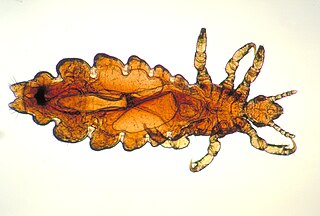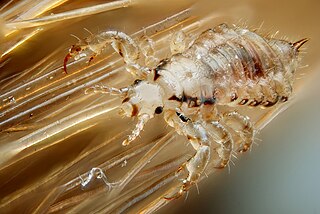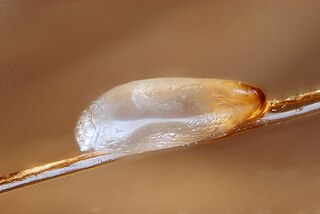Related Research Articles
Louse is the common name for any member of the clade Phthiraptera, which contains nearly 5,000 species of wingless parasitic insects. Phthiraptera has variously been recognized as an order, infraorder, or a parvorder, as a result of developments in phylogenetic research.

The crab louse or pubic louse is an insect that is an obligate ectoparasite of humans, feeding exclusively on blood. The crab louse usually is found in the person's pubic hair. Although the louse cannot jump, it can also live in other areas of the body that are covered with coarse hair, such as the perianal area, the entire body, and the eyelashes.

Pediculosis is an infestation of lice from the sub-order Anoplura, family Pediculidae. Accordingly, the infestation with head lice is named pediculosis capitis, while this with body lice, pediculosis corporis. Although pediculosis in humans may properly refer to lice infestation of any part of the body, the term is sometimes used loosely to refer to pediculosis capitis, the infestation of the human head with the specific head louse.

The head louse is an obligate ectoparasite of humans. Head lice are wingless insects that spend their entire lives on the human scalp and feed exclusively on human blood. Humans are the only known hosts of this specific parasite, while chimpanzees and bonobos host a closely related species, Pediculus schaeffi. Other species of lice infest most orders of mammals and all orders of birds.
A bird louse is any chewing louse of order Phthiraptera which parasitizes warm-blooded animals, especially birds. Bird lice may feed on feathers, skin, or blood. They have no wings, and their biting mouth parts distinguish them from true lice, which suck blood.

The treatment of human lice is the removal of head lice parasites from human hair. It has been debated and studied for centuries. However, the number of cases of human louse infestations has increased worldwide since the mid-1960s, reaching hundreds of millions annually. There is no product or method that assures 100% destruction of the eggs and hatched lice after a single treatment. However, there are a number of treatment modalities that can be employed with varying degrees of success. These methods include chemical treatments, natural products, combs, shaving, hot air, and silicone-based lotions.

Menoponidae is a monophyletic family of lice in the superfamily of chewing lice, Amblycera, often referred to as the chicken body louse family. They are ectoparasites of a wide range of birds including chickens, which makes them important to understand for veterinary science and for human health. However, Menoponidae are not exclusive to poultry and are common parasites for migratory birds, with more and more species being discovered every year.

Sea lice are copepods of the family Caligidae within the order Siphonostomatoida. They are marine ectoparasites that feed on the mucus, epidermal tissue, and blood of host fish. The roughly 559 species in 37 genera include around 162 Lepeophtheirus and 268 Caligus species.

The body louse is a hematophagic ectoparasite louse that infests humans. It is one of three lice which infest humans, the other two being the head louse, and the crab louse or pubic louse.

Haematopinus is a genus of insects in the superfamily Anoplura, the sucking lice. It is the only genus in the family Haematopinidae, known commonly as the ungulate lice. All known species are of importance in veterinary medicine. These lice are some of the most economically important ectoparasites of domestic animals. Species infest many domesticated and wild large mammals, including cattle, horses, donkeys, swine, water buffalo, African buffalo, antelope, zebra, deer, and camels. The species Haematopinus tuberculatus has great importance in the water buffalo breading, since this louse is specific to buffaloes, being the main ectoparasite of the species, with important sanitary and economic burden. The Haematopinus tuberculatus is suspected to be involved in the transmission of diseases, such as anaplasmosis. The parasites are found infesting buffaloes in greater concentrations around the ears, base of horns, side of the neck, around the scrotum or udder, and especially at the tip of the tail.
A louse is a wingless insect.
An ectoparasiticide is an antiparasitic drug used in the treatment of ectoparasitic infestations. These drugs are used to kill the parasites that live on the body surface. Permethrin, sulfur, lindane, dicophane, benzyl benzoate, ivermectin and crotamiton are well known ectoparasiticides.

Head lice infestation, also known as pediculosis capitis, is the infection of the head hair and scalp by the head louse. Itching from lice bites is common. During a person's first infection, the itch may not develop for up to six weeks. If a person is infected again, symptoms may begin much more quickly. The itch may cause problems with sleeping. Generally, however, it is not a serious condition. While head lice appear to spread some other diseases in Africa, they do not appear to do so in Europe or North America.

No nit policy is a public health policy implemented by some education authorities to prevent the transmission of head lice infestation. The "no nit" policy requires the sending home and barring of all children who have nits on their hair from controlled settings such as school, summer camp or day care facilities. The CDC, American Academy of Pediatrics (AAP) and the National Association of School Nurses (NASN) advocate that "no-nit" policies should be discontinued, due in part because nits, the eggs or empty egg shells, are not transmissible and the burden of unnecessary absenteeism to the students, families and communities far outweighs the risks associated with head lice. Proponents of the no-nit policy counter that only a consistently nit-free child can be reliably shown to be infestation-free. That is, the presence of nits serves as a proxy for infestation status. Proponents argue that such a proxy is necessary because lice screening is prone to false negative conclusions.

Pediculosis corporis or Vagabond's disease is a cutaneous condition caused by body lice that lay their eggs on clothing and to a lesser extent on human hairs.
Infestation is the state of being invaded or overrun by pests or parasites. It can also refer to the actual organisms living on or within a host.

Pediculosis pubis is an infestation by the pubic louse, Pthirus pubis, a wingless insect which feeds on blood and lays its eggs (nits) on mainly pubic hair. Less commonly, hair near the anus, armpit, beard, eyebrows, moustache, and eyelashes may be involved. It is usually acquired during sex, but can be spread via bedding, clothing and towels, and is more common in crowded conditions where there is close contact between people.

Diseases and parasites in salmon, trout and other salmon-like fishes of the family Salmonidae are also found in other fish species. The life cycle of many salmonids is anadromous, so such fish are exposed to parasites in fresh water, brackish water and saline water.

The Ricinidae are a family of a larger group Amblycera of the chewing lice. All species are relatively large bodied avian ectoparasites. They typically exhibit low prevalence and low intensity. They feed on host blood which is atypical in chewing lice. Two or three genera are recognized.

Cryptolepas rhachianecti is a species of whale barnacle that lives as a passenger on the skin of gray whales and certain other species of whale in the northern Pacific Ocean.
References
- ↑ "Ectoparasites and endoparasites". The Open University.
- ↑ Estrada B (January 2003). "Ectoparasitic infestations in homeless children". Semin Pediatr Infect Dis. 14 (1): 20–4. doi:10.1053/spid.2003.127213. PMID 12748918.